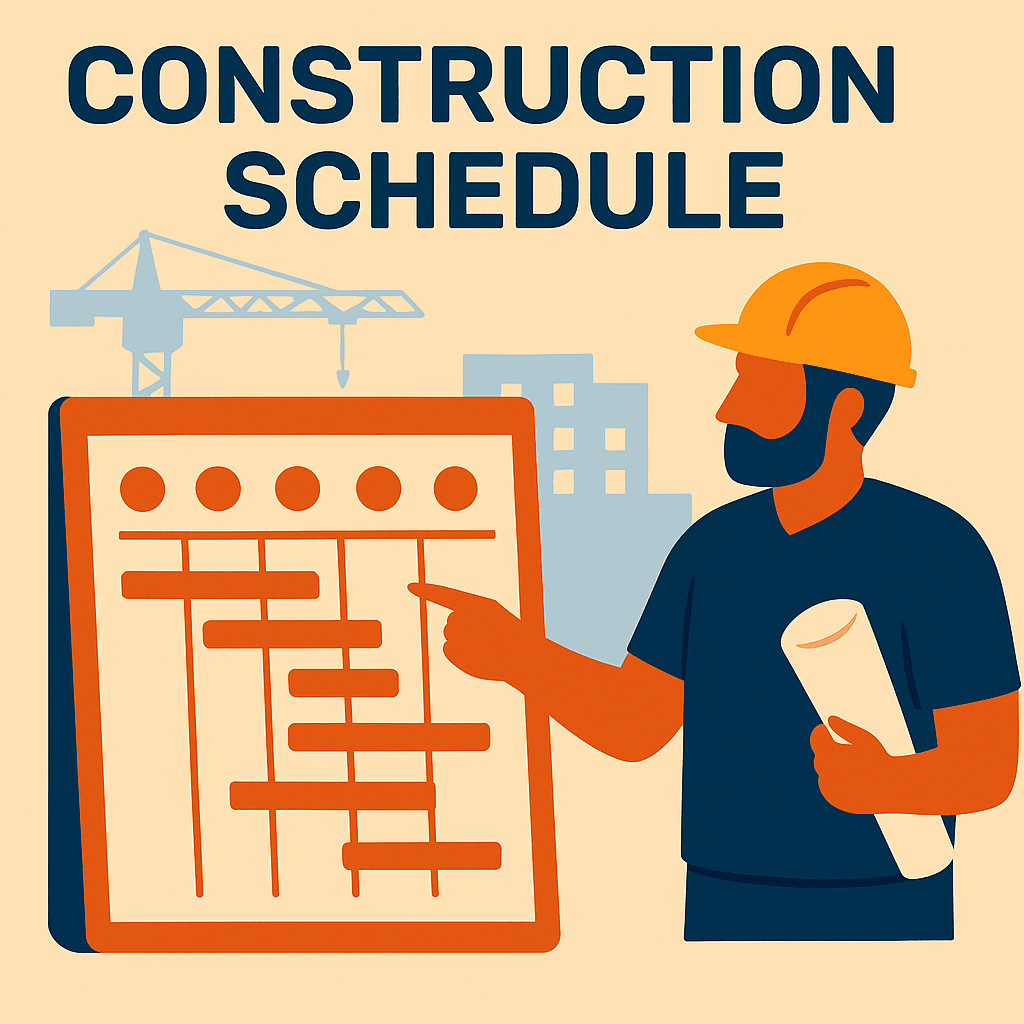Why Every Builder Needs a Realistic Construction Schedule
In the world of construction, time is money — and nothing keeps your project on track more effectively than a clear, well-structured construction schedule. Without one, deadlines slip, budgets spiral, and client trust erodes. With one, you can coordinate trades, secure materials on time, and deliver a smooth, stress-free build.
A construction schedule isn’t just a document you create to tick a box. It’s the backbone of your project management process, outlining every stage from the first site visit to the final handover. Done right, it helps you anticipate challenges, allocate resources efficiently, and maintain accountability among all stakeholders.

At BuilderExpert, we’ve seen first-hand how a well-planned schedule can transform project outcomes. Using tools like Detailed Estimates and Real-Time Pricing, builders can align their timelines with actual costs and availability — creating schedules that are not just realistic, but achievable.
Whether you’re overseeing a small renovation or a large-scale development, this guide will walk you through:
- What a construction schedule is and why it matters
- The key factors that influence timelines
- A step-by-step process for creating your own
- Common pitfalls and how to avoid them
- The best tools for professional scheduling
Ready to take control of your timelines? Register with BuilderExpert here and start building schedules that actually work — every time.
Section 1 – What is a Construction Schedule & Why It’s Essential
A schedule is the master plan that keeps your building project organised and on track. It outlines every stage of work, assigns responsibilities, and sets deadlines so that nothing slips through the cracks.
Without it, you’re essentially running your project blind — which usually means delays, confusion, and extra costs. With it, you have a clear roadmap from day one to final handover.
Defining a Construction Schedule
A construction schedule details:
- What needs to be done
- When each task should happen
- Who is responsible for delivering it
It’s not just a date list. It’s a dynamic project management tool that guides everyone from site managers to subcontractors.
Why It’s a Non-Negotiable for Builders
Keeps projects moving efficiently
A well-planned schedule helps you avoid gaps in workflow and ensures materials and labour are available exactly when needed.
Boosts client confidence
Homeowners and developers alike want assurance their project is in safe hands. A clear, realistic schedule sends that message instantly.
In the UK, whether you’re planning a home renovation or managing a large-scale commercial build, the principles remain the same: clarity, precision, and adaptability.
In the next section, we’ll explore the key factors that determine how long your schedule should be and how realistic it is.
Section 2 – Key Factors That Influence a Construction Schedule
Not all building projects are created equal. Even with the best planning, some will naturally take longer than others. Understanding the main factors that impact your schedule will help you set realistic timelines and avoid unnecessary delays.
1. Project Size and Complexit
A small kitchen refurbishment is very different from a multi-storey extension. Larger projects mean more trades, more materials, and more potential bottlenecks. Complex designs — such as structural alterations, basements, or integrating advanced building systems — add further time.
2. Planning Permissions and Regulatory Approvals
The approval process can be a timeline killer
In the UK, many projects require planning permission and building regulations approval before work can begin. Delays here may come from:
- Local authority processing times
- Neighbour objections
- Revisions to plans
- Additional surveys or reports
Some builds qualify for permitted development rights, but most still require formal approval. A late start here pushes back the entire schedule plan .
3. Design Changes Mid-Project
Even small changes can have a ripple effect. A last-minute alteration to a layout or materials can disrupt suppliers’ schedules, push back subcontractor work, and require re-approvals.
4. Material and Labour Availability
Shortages of materials or skilled workers can bring work to a standstill. Partnering with suppliers early and using tools like Real-Time Pricing helps align your project construction schedule with actual availability.
5. Weather and Site Conditions
Rain, frost, and extreme winds can delay outdoor work — especially in foundation, roofing, or external finishing stages. Poor soil conditions can also slow groundwork.
6. Project Management and Communication
A schedule is only as good as the team executing it. Builders who use systems like Bill of Quantity in Construction Estimating and maintain clear communication between trades see far fewer overruns.
Section 3 – Step-by-Step Guide to Creating a Construction Schedule
Creating a schedule that works in the real world takes more than filling out dates on a spreadsheet. It’s about building a logical sequence of tasks, aligning resources, and allowing enough flexibility to adapt to real-life changes.
Step 1 – Define the Project Scope and Goals
Before you can plan dates, you need clarity on what’s being built. This means:
- Understanding the full scope of works
- Confirming design plans
- Setting clear project objectives
Step 2 – Break the Project into Manageable Phases
Example: Residential Construction Schedule Phases
For a typical residential construction schedule, you might break it down into:
- Pre-construction planning and approvals
- Site preparation and groundwork
- Structural works
- Roofing and weatherproofing
- First fix (electrical, plumbing, HVAC)
- Second fix and finishes
- Final inspections and handover
Breaking the job into phases makes it easier to track progress and spot delays early.
Step 3 – Sequence Tasks in the Right Order
Some tasks can’t start until others are complete. For example, you can’t begin interior plastering until the building is watertight. Creating a critical path prevents overlaps that cause wasted time.
Step 4 – Assign Responsibilities
Using Accountability to Keep the Schedule on Track
Every task in your project plan should have a named person or subcontractor responsible for it. This makes follow-up easier and ensures accountability.
Step 5 – Estimate Time for Each Task
Be realistic, not optimistic. Use past project data, supplier lead times, and advice from experienced trades to set achievable durations.
Step 6 – Add Contingency Time
Unexpected delays are inevitable. Including contingency days (or weeks for bigger builds) gives breathing room without derailing the overall schedule.
Section 4 – Tools and Templates for a Professional Construction Schedule
Even the most experienced builders benefit from having the right tools to create and maintain a schedule. While hand-written plans or basic spreadsheets can work for very small jobs, larger projects require more structured and trackable formats.
One popular starting point is a construction schedule template for excel. These templates provide a ready-made structure with columns for tasks, durations, dependencies, and deadlines. However, they have their limitations — particularly when it comes to live updates, collaboration, and integrating with cost estimates.
This is where platforms like BuilderExpert outperform static templates. With features like the Construction Project Workflow and Estimate Tasks Breakdown, you can manage your schedule alongside costs, materials, and subcontractor coordination — all in one place.
The more connected your scheduling process is to real-time data, the less likely you are to face unexpected delays or cost overruns.
Section 5 – Common Mistakes When Creating a Construction Schedule
Even with the best intentions, many builders fall into traps that compromise their schedule before the project even begins. Recognising these mistakes early can save you time, money, and client frustration.
1. Overly optimistic timelines
Many schedules are built on best-case scenarios. While optimism is good, it’s dangerous if you don’t account for delays caused by weather, material shortages, or client indecision.
2. Poor communication with stakeholders
If architects, engineers, subcontractors, and suppliers aren’t aligned with your schedule, you risk gaps in workflow and costly downtime.
3. Ignoring dependencies
Certain tasks can’t begin until others are complete. Missing these links in your schedule can cause work to stall unexpectedly.
4. Lack of flexibility
A rigid plan that can’t adapt to changes is as bad as no plan at all. Your schedule should be a living document that evolves with the project.
5. Not using the right tools
Relying solely on paper notes or outdated spreadsheets leaves room for error. Platforms like Detailed Construction Estimate and Bill of Quantity in Construction Estimating help align scheduling with costs and resource planning.
By avoiding these pitfalls, you can create a schedule that actually supports — rather than hinders — the success of your build.
Section 6 – Final Tips for Creating a Construction Schedule That Works
A truly effective schedule is more than a set of dates on a calendar — it’s a dynamic plan that keeps everyone accountable and the project moving forward. To make yours work in the real world, focus on these final best practices:
- Start with accurate estimates — Tools like Real-Time Pricing ensure your schedule matches real-world availability and costs.
- Involve all stakeholders early — The more input you get before finalising your schedule, the fewer changes you’ll need later.
- Plan for the unexpected — Always include contingency days for weather, delivery delays, or last-minute design updates.
- Track and update regularly — Treat your schedule as a living document, updating it whenever progress or circumstances change.
Summary
A well-structured project timeline isn’t just a nice-to-have — it’s one of the most powerful tools a builder can use to stay organised, meet deadlines, and keep clients happy. By breaking work into clear phases, assigning responsibilities, and planning for potential delays, you can run projects with confidence and avoid unnecessary stress.
Using modern estimating and planning tools, like those available from BuilderExpert, makes the process even smoother. They help align costs, materials, and labour availability so your plan isn’t just theoretical, but genuinely achievable.
Whether you’re managing a small home renovation or a complex commercial build, taking the time to map out each stage from start to finish pays off in fewer disputes, less wasted time, and better overall results. Good planning doesn’t just build structures — it builds trust.
You can also connect with BuilderExpert on social media for updates, tips, and industry insights. Follow us on Facebook and LinkedIn to stay informed and engaged with the latest in construction estimating and project management.

